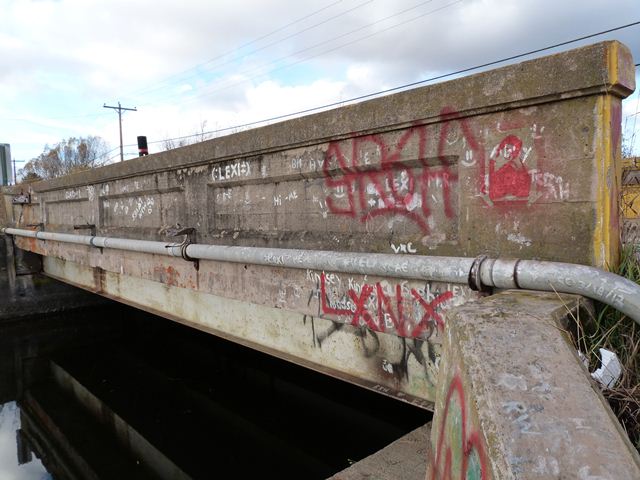We Recommend:
Bach Steel - Experts at historic truss bridge restoration.
Old US-41 Pike River Bridge
Trunk Line Bridge Number 8

Primary Photographer(s): Nathan Holth
Bridge Documented: October 1, 2012
Rural: Houghton County, Michigan: United States
1914 By Builder/Contractor: Smith-Byers-Sparks Company of Houghton, Michigan and Engineer/Design: Michigan State Highway Department
1966
36.7 Feet (11.2 Meters)
37.7 Feet (11.5 Meters)
19 Feet (5.79 Meters)
1 Main Span(s)
3425

View Information About HSR Ratings
Bridge Documentation
View Archived National Bridge Inventory Report - Has Additional Details and Evaluation
This bridge is one of the first state highway bridges ever built in Michigan, in fact the 8th bridge authorized to be built under the 1913 State Trunk Line Act. This is why the bridge was designated Trunk Line Bridge #8. The bridge is significant as one of the first such bridges built. The bridge is not structurally rare or unusual; it is a steel stringer bridge. However, it is an early and unaltered example of this bridge type in Michigan. The bridge has been closed to traffic. It appears to have abutment problems at the northwestern end, with a large crack in the abutment wall visible. The superstructure is in overall decent condition.
Information and Findings From Michigan Historic Bridge InventoryNarrative Description Located in Chassell Township, this small-scale concrete/steel bridge spans the Pike River on County Road C117. The crossing is situated immediately south of the village of Chassell, near the river's mouth at Pike
Bay. The structure is configured as a 38-foot, steel stringer span, with five lines of rolled I-beams supported simply by concrete abutments. Architectural expression is provided by MSHD standard paneled concrete guardrails. Cast
into the guardrails are "State Trunk Line Bridge 1914" on one side and "Built by S-B-S Co Houghton" on the other. In unaltered and excellent structural condition, the Pike River Bridge has retained a high degree of physical
integrity. |
![]()
Photo Galleries and Videos: Old US-41 Pike River Bridge
Bridge Photo-Documentation
Original / Full Size PhotosA collection of overview and detail photos. This gallery offers photos in the highest available resolution and file size in a touch-friendly popup viewer.
Alternatively, Browse Without Using Viewer
![]()
Bridge Photo-Documentation
Mobile Optimized PhotosA collection of overview and detail photos. This gallery features data-friendly, fast-loading photos in a touch-friendly popup viewer.
Alternatively, Browse Without Using Viewer
![]()
Maps and Links: Old US-41 Pike River Bridge
Coordinates (Latitude, Longitude):
Search For Additional Bridge Listings:
Bridgehunter.com: View listed bridges within 0.5 miles (0.8 kilometers) of this bridge.
Bridgehunter.com: View listed bridges within 10 miles (16 kilometers) of this bridge.
Additional Maps:
Google Streetview (If Available)
GeoHack (Additional Links and Coordinates)
Apple Maps (Via DuckDuckGo Search)
Apple Maps (Apple devices only)
Android: Open Location In Your Map or GPS App
Flickr Gallery (Find Nearby Photos)
Wikimedia Commons (Find Nearby Photos)
Directions Via Sygic For Android
Directions Via Sygic For iOS and Android Dolphin Browser
USGS National Map (United States Only)
Historical USGS Topo Maps (United States Only)
Historic Aerials (United States Only)
CalTopo Maps (United States Only)

